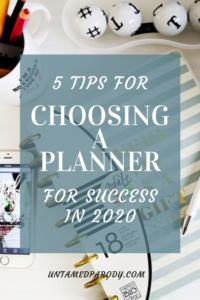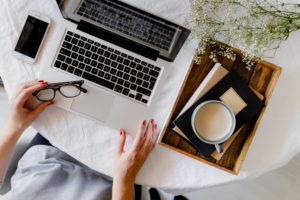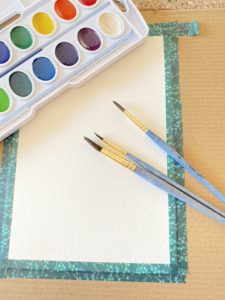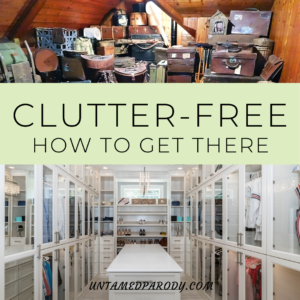
Using a planner on a daily basis is an excellent way to organize your life, relieve stress, and complete goals. Choosing the right planner for your lifestyle is key. Here are five great tips for choosing the perfect paper planner, and a bit about electronic.
Consider the Size
Consider where you’ll be using it, and what pages to include. You can choose from a wide variety of pre-printed planners by the major players like FranklinCovey, BlueSky, Erin Condren or Emily Ley (jump to the bottom of this article for some of my favorites). Or, there are a number of Etsy businesses and bloggers who design and sell planners in PDF form that you download and print yourself.
There are small, medium, and large sizes to choose from. Key is to think about whether you’ll leave it on your desk or tote it with you in your purse, backpack or briefcase. Another consideration is…how big you write. That’s right….how big you write! I do not have small penmanship, especially when I’m in a hurry. I’m also not a neat writer. So, going small is a recipe for my failure, believe me, I’ve tried. While I used a 5″ x 8″ (medium; FranklinCovey calls it a “classic”) size for many year, my most comfortable size is roughly 8″ x 10″.
Look at the Layouts
While you will probably fill this planner with more pages as you think of additional things to track, look at the layouts of pages it comes with. This is when you think about what you will be tracking, and how many pages you need for writing or adding your own custom information.
When thinking about layout, consider too whether a ring-bound or spiral-bound style suits you best. This is especially important for the lefties out there…sometimes left-handed folks have issues with where things are bound. For me, I’ve found a spiral-bound or traditional bound (like a book) work best. They tend to lay flatter, but more importantly for me, they’re also thinner than most ring-bound planners.
I’m also pretty picky about the amount of space that’s available. I prefer a planner that has the time blocks printed on each day. That way, I can time-block myself throughout the day. I also prefer a layout that has a full month view plus each day laid out vertically. The month-view enables me to see at a glance what I have going on and when a day looks like it’s getting overbooked. The daily view enables me to see where I have holes in the week that I can schedule.
What Pages do You Want?
As you are looking at layouts of the pages, look at the different types of pages as well. Some planners keep it very basic where it’s primarily the monthly and weekly calendar pages, while others fit in a lot of extras, such as blank pages for journaling, to-do lists, task lists, trackers, and a lot more.
Historically, I’ve keep my planners pretty simple – month calendar, week at a glance pages, note pages. There was a time when I used a FranklinCovey ring-binder that I literally kept my entire life in that binder. When it got stolen at an airport, I decided pretty quickly to keep only what I needed to function for work and play in my planner. This year (2020), I’m trying a new style of planner designed by Commit30. (link available, but I’m not paid to endorse or promote). It’s really focused on goal setting and achievement, and as of this writing, I’m still working my way through setting it up. But I like it! And, it’s a beautiful soft-sided book that fits neatly into my briefcase and my purse, despite its size (8″ x 10″, roughly).
What is it Being Used for?
Still not sure what planner you want? Think about what you are going to use it for. This might be for your daily life and schedules, work and projects, home life, personal or a combination of all of these. This determines everything from the size to the type of pages included in your planner. It will also help you figure out if a store-bought planner works, or if you will get a binder and just use printable planner pages.
I know several people who keep two planners – one for home and one for work. I would be so screwed up if I did that, so it’s important for me to have a single planner that I can use all year long. If needed, I tuck in additional pages, and I’m a whiz with sticky notes! I feel strongly that to truly take control of your whole life, you need to see it all in one spot. It’s certainly your call to use one or more planners, but be sure to think about how you’re going to keep everything tied together.
A Word About Electronic Calendars
I will be the first to admit that if there’s an app for it, I probably have it on my iPhone, iPad and MacBook. Many moons ago when electronic planners first hit the scene, I was an early adopter. Think Palm Pilot, Blackberry, etc…(yeah, I’m that old), and I was on it and using it. But, I found having only an electronic calendar was never as successful as having a paper companion version. Too often, I found myself overbooked, thanks in part to a company that loved to have lots of meetings, leaving little time to actually do my job. I also found that when it came to goals, having them right under my nose in the most accessible format – in my paper planner – greatly increased by success at achieving them. I could also jot notes about what I was doing, what I needed to explore, or brain dump on them quickly and efficiently.
So, today I use the calendar app synched on my iPhone/iPad/MacBook mainly for the alarm feature. But my daily “bible” is my paper planner. As a meeting is electronically scheduled onto my electronic device, I scribble a note in my paper planner. As I schedule a meeting over the phone or on email, I look to my paper planner to layout my day/week/month to find the perfect spot.
Tell me about your perfect planner! Love to hear how you use it to be successful….comment below.
Some of My Favorites





